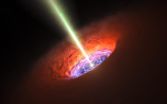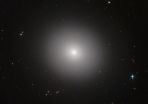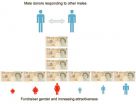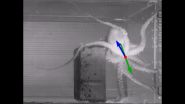(Press-News.org) Astronomers from Chalmers University of Technology have used the giant telescope Alma to reveal an extremely powerful magnetic field very close to a supermassive black hole in a distant galaxy. The results appear in the 17 April 2015 issue of the journal Science.
A team of five astronomers from Chalmers University of Technology have revealed an extremely powerful magnetic field, beyond anything previously detected in the core of a galaxy, very close to the event horizon of a supermassive black hole. This new observation helps astronomers to understand the structure and formation of these massive inhabitants of the centres of galaxies, and the twin high-speed jets of plasma they frequently eject from their poles.
Up to now only weak magnetic fields far from black holes -- several light-years away -- had been probed. In this study, however, astronomers from Chalmers University of Technology and Onsala Space Observatory in Sweden have now used Alma to detect signals directly related to a strong magnetic field very close to the event horizon of the supermassive black hole in a distant galaxy named PKS 1830-211. This magnetic field is located precisely at the place where matter is suddenly boosted away from the black hole in the form of a jet.
The team measured the strength of the magnetic field by studying the way in which light was polarised, as it moved away from the black hole.
"Polarisation is an important property of light and is much used in daily life, for example in sun glasses or 3D glasses at the cinema," says Ivan Marti-Vidal, lead author of this work.
"When produced naturally, polarisation can be used to measure magnetic fields, since light changes its polarisation when it travels through a magnetised medium. In this case, the light that we detected with Alma had been travelling through material very close to the black hole, a place full of highly magnetised plasma."
The astronomers applied a new analysis technique that they had developed to the Alma data and found that the direction of polarisation of the radiation coming from the centre of PKS 1830-211 had rotated.
Magnetic fields introduce Faraday rotation, which makes the polarisation rotate in different ways at different wavelengths. The way in which this rotation depends on the wavelength tells us about the magnetic field in the region.
The Alma observations were at an effective wavelength of about 0.3 millimetres, the shortest wavelengths ever used in this kind of study. This allows the regions very close to the central black hole to be probed. Earlier investigations were at much longer radio wavelengths. Only light of millimetre wavelengths can escape from the region very close to the black hole; longer wavelength radiation is absorbed.
"We have found clear signals of polarisation rotation that are hundreds of times higher than the highest ever found in the Universe," says Sebastien Muller, co-author of the paper. "Our discovery is a giant leap in terms of observing frequency, thanks to the use of Alma, and in terms of distance to the black hole where the magnetic field has been probed -- of the order of only a few light-days from the event horizon. These results, and future studies, will help us understand what is really going on in the immediate vicinity of supermassive black holes."
INFORMATION:
More about the research
This research was presented in a paper entitled "A strong magnetic field in the jet base of a supermassive black hole" to appear in Science on 17 April 2015, vol 348, issue 6232.
The team is composed of Ivan Martí-Vidal (Onsala Space Observatory and Department of Earth and Space Sciences, Chalmers University of Technology, Sweden), Sebastien Muller (Onsala Space Observatory and Department of Earth and Space Sciences, Chalmers University of Technology, Sweden), Wouter Vlemmings (Department of Earth and Space Sciences and Onsala Space Observatory, Chalmers University of Technology, Sweden), Cathy Horellou (Department of Earth and Space Sciences, Chalmers University of Technology, Sweden) and Susanne Aalto (Department of Earth and Space Sciences, Chalmers University of Technology, Sweden).
More about Alma
Alma (Atacama Large Millimeter/submillimeter Array) -- with its 66 gigantic 12-metre and 7-metre antennas - is an international astronomy facility located at 5000 metres altitude at Chajnantor in northern Chile. Alma is a partnership of Europe, North America and East Asia in cooperation with the Republic of Chile and is the world's largest astronomy project. Chalmers and Onsala Space Observatory have been part of Alma since its inception; receivers for the telescope are one of many contributions. Onsala Space Observatory is host to the Nordic Alma Regional Centre, which provides technical expertise to the Alma project and supports astronomers in the Nordic countries in using Alma.
More about Onsala Space Observatory
Onsala Space Observatory is Sweden's national facility for radio astronomy. The observatory provides researchers with equipment for the study of the earth and the rest of the universe. In Onsala, 45 km south of Gothenburg, it operates two radio telescopes and a station in the international telescope Lofar. It also participates in several international projects. The observatory is hosted by Department of Earth and Space Sciences at Chalmers University of Technology, and is operated on behalf of the Swedish Research Council.
Contacts:
Robert Cumming, astronomer and communications officer, Onsala Space Observatory, Chalmers, +46 31-772 5500, +46 70-493 31 14, robert.cumming@chalmers.se
Ivan Martí-Vidal, astronomer, Onsala Space Observatory, Chalmers, +46 31 772 5557, ivan.marti-vidal@chalmers.se
Astronomers have shown for the first time how star formation in "dead" galaxies sputtered out billions of years ago. The NASA/ESA Hubble Space Telescope and ESO's Very Large Telescope (VLT) have revealed that three billion years after the Big Bang, these galaxies still made stars on their outskirts, but no longer in their interiors. The quenching of star formation seems to have started in the cores of the galaxies and then spread to the outer parts. The results will be published in the 17 April 2015 issue of the journal Science.
A major astrophysical mystery has centred ...
"The answers to extinction, survival and evolution are right here in the dirt," says University of Cincinnati Quaternary science researcher Ken Tankersley, associate professor of anthropology and geology. "And we are continually surprised by what we find."
While many scientists focus on species' extinction wherever there has been rapid and profound climate change, Tankersley looks closely at why certain species survived.
For many years he has invited students and faculty from archeology and geology, and representatives from the Cincinnati Museum Center and Kentucky ...
Washington, DC--Drinking sugar-sweetened beverages can suppress the hormone cortisol and stress responses in the brain, but diet beverages sweetened with aspartame do not have the same effect, according to a new study published in the Endocrine Society's Journal of Clinical Endocrinology & Metabolism.
"This is the first evidence that high sugar - but not aspartame - consumption may relieve stress in humans," said one of the study's authors, Kevin D. Laugero, PhD, of the University of California, Davis, and the U.S. Department of Agriculture's Agricultural Research Service. ...
Washington, DC--People who have osteoporosis face a 1.76-fold higher risk of developing sudden deafness than those who do not have the bone disease, according to a new study published in the Endocrine Society's Journal of Clinical Endocrinology & Metabolism.
Osteoporosis is a progressive condition in which bones become structurally weak and are more likely to fracture or break, according to the Hormone Health Network. More than 40 million people nationwide already have osteoporosis or are at risk of developing the condition due to low bone mass, according to the National ...
This news release is available in French. Quebec City, April 16, 2015--An international study led by researchers from Université Laval and CHU de Québec-Université Laval has identified significant vascular changes in the brains of people with Huntington's disease. This breakthrough, the details of which are published in the most recent issue of Annals of Neurology, will have significant implications for our understanding of the disease and could open the door to new therapeutic targets for treating this fatal neurodegenerative condition.
Huntington's ...
If you are looking to raise money online for your favorite cause, listen up. A real-world analysis of human behavior reported in the Cell Press journal Current Biology on April 16 shows that men treat online giving as a competitive enterprise. Men will donate four times more money to an attractive female fundraiser in response to the contribution of another male.
Researchers say that they suspect this tendency is a subconscious part of human psychology that exists because it is (or was) evolutionarily beneficial to us.
"People are really generous and are right, a lot ...
The body plan of octopuses is nothing if not unique, with a sophisticated brain in a soft, bilaterally symmetrical body, encircled by eight radially symmetrical and incredibly flexible arms. Now, researchers reporting the first detailed kinematic analysis of octopus arm coordination in crawling show that the animals have a unique motor control strategy to match their "odd" form. The researchers report their findings in the Cell Press journal Current Biology on April 16.
"Octopuses use unique locomotion strategies that are different from those found in other animals," ...
Bacteria that naturally reside in the gut are important for health, but recent studies consistently show that a modern lifestyle depletes the gut's collection of microbes. How lifestyle affects the diversity of this gut "microbiome" is unclear, but an analysis of the gut microbiomes of Papua New Guinean and US residents in Cell Reports now suggests that western lifestyle may diminish the variety of bacteria in the gastrointestinal tract by limiting their ability to be transmitted among humans.
"There are several aspects of western lifestyle that have been hypothesized ...
Oral infections are the most common diseases of mankind and are also a key risk factor for heart disease, which is the leading cause of death worldwide. In a review article published in Trends in Endocrinology and Metabolism on April 16, researchers summarize the latest clinical evidence supporting a link between oral infections, which are caused by the bacteria in our mouth, and heart disease, and they emphasize the important role of inflammation in both of these conditions.
"Given the high prevalence of oral infections, any risk they contribute to future cardiovascular ...
By analyzing the activity of "GPS" neurons in mice, researchers at the Stanford University School of Medicine have discovered that the mental maps created by these cells accumulate errors, which are corrected when the animal encounters a wall.
The findings support the theory that these cells, called grid cells, use an animal's perceived speed and direction to help it navigate familiar places.
Thus, as you stumble through your pitch-black kitchen in the middle of the night for a glass of water, your body knows how many steps to take and when to turn to get to the sink. ...






